BMP3002 Business in Practice: Types of Companies and External Factors
VerifiedAdded on 2022/11/29
|13
|2761
|147
Report
AI Summary
This report provides a comprehensive overview of various company types, ranging from micro-businesses to large corporations, and explores different business structures such as sole traders, partnerships, and limited liability companies. It delves into the characteristics of each type, highlighting their operational aspects and market presence. Furthermore, the report examines the impact of external factors, such as political, economic, social, technological, environmental, and legal (PESTLE) factors, on business performance and productivity, providing an understanding of how these factors influence organizational strategies and outcomes. The analysis includes an examination of functional and divisional organizational structures and their effects on business operations. The report aims to provide a thorough understanding of business structures and external factors affecting business.
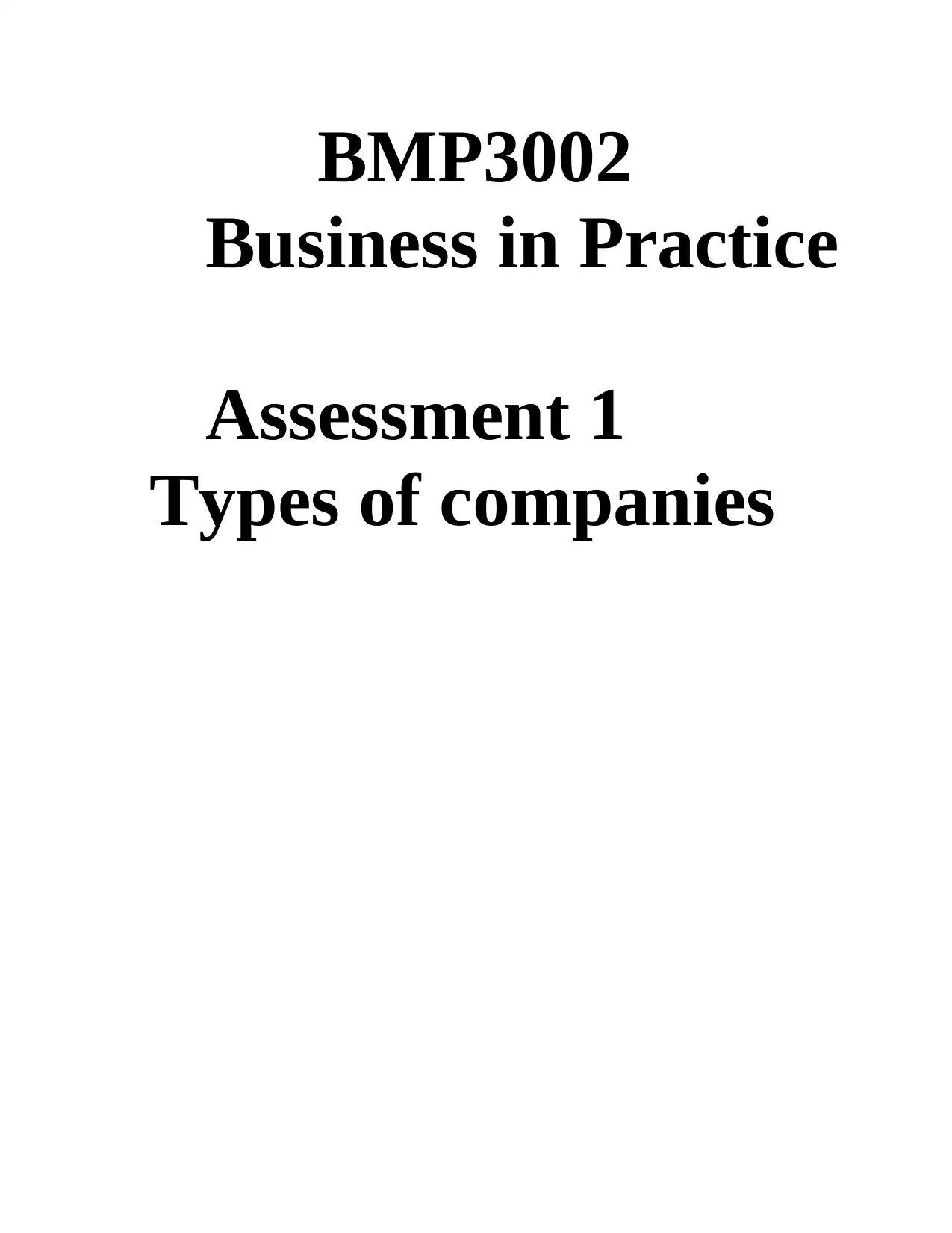
BMP3002
Business in Practice
Assessment 1
Types of companies
Business in Practice
Assessment 1
Types of companies
Paraphrase This Document
Need a fresh take? Get an instant paraphrase of this document with our AI Paraphraser
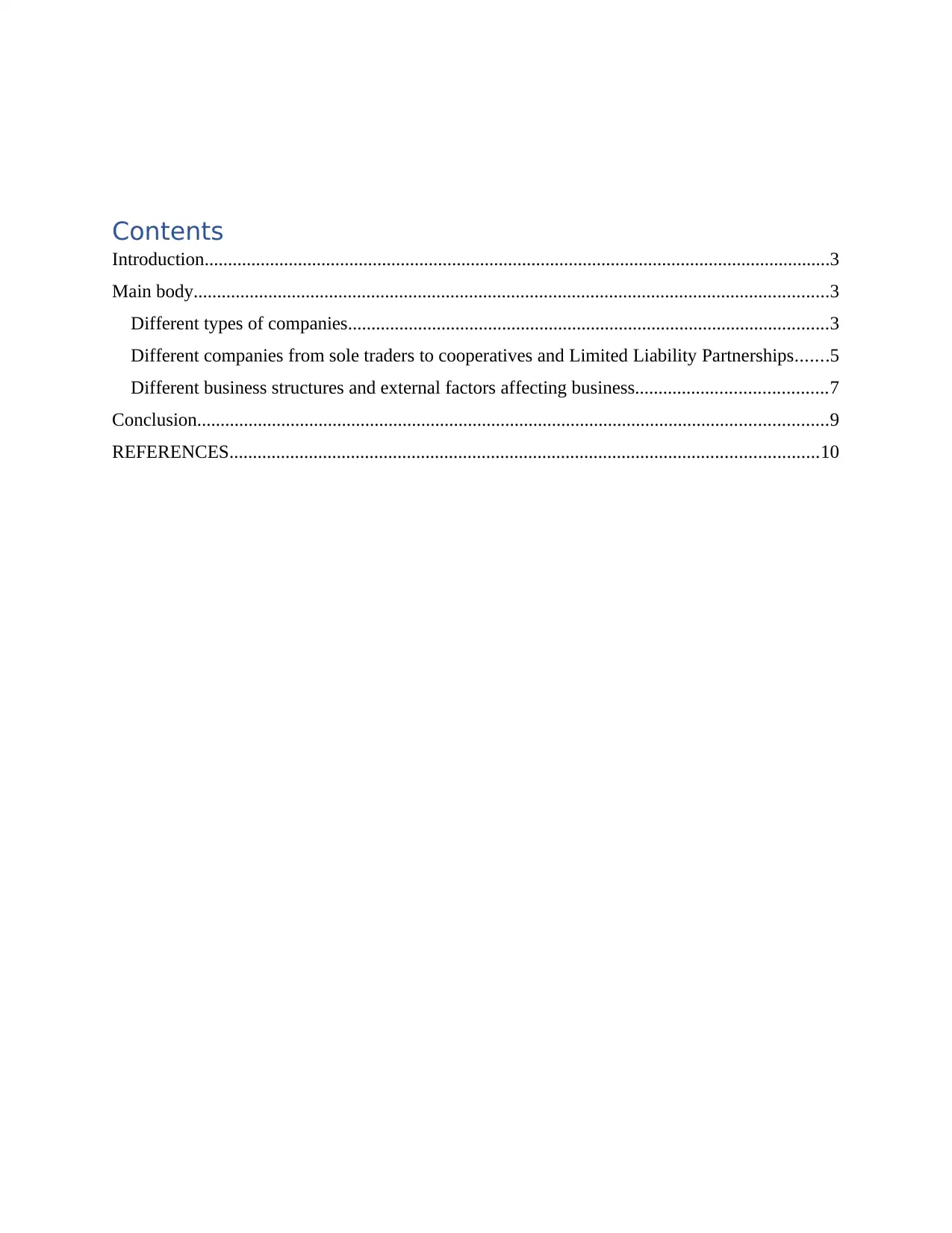
Contents
Introduction......................................................................................................................................3
Main body........................................................................................................................................3
Different types of companies.......................................................................................................3
Different companies from sole traders to cooperatives and Limited Liability Partnerships.......5
Different business structures and external factors affecting business.........................................7
Conclusion.......................................................................................................................................9
REFERENCES..............................................................................................................................10
Introduction......................................................................................................................................3
Main body........................................................................................................................................3
Different types of companies.......................................................................................................3
Different companies from sole traders to cooperatives and Limited Liability Partnerships.......5
Different business structures and external factors affecting business.........................................7
Conclusion.......................................................................................................................................9
REFERENCES..............................................................................................................................10
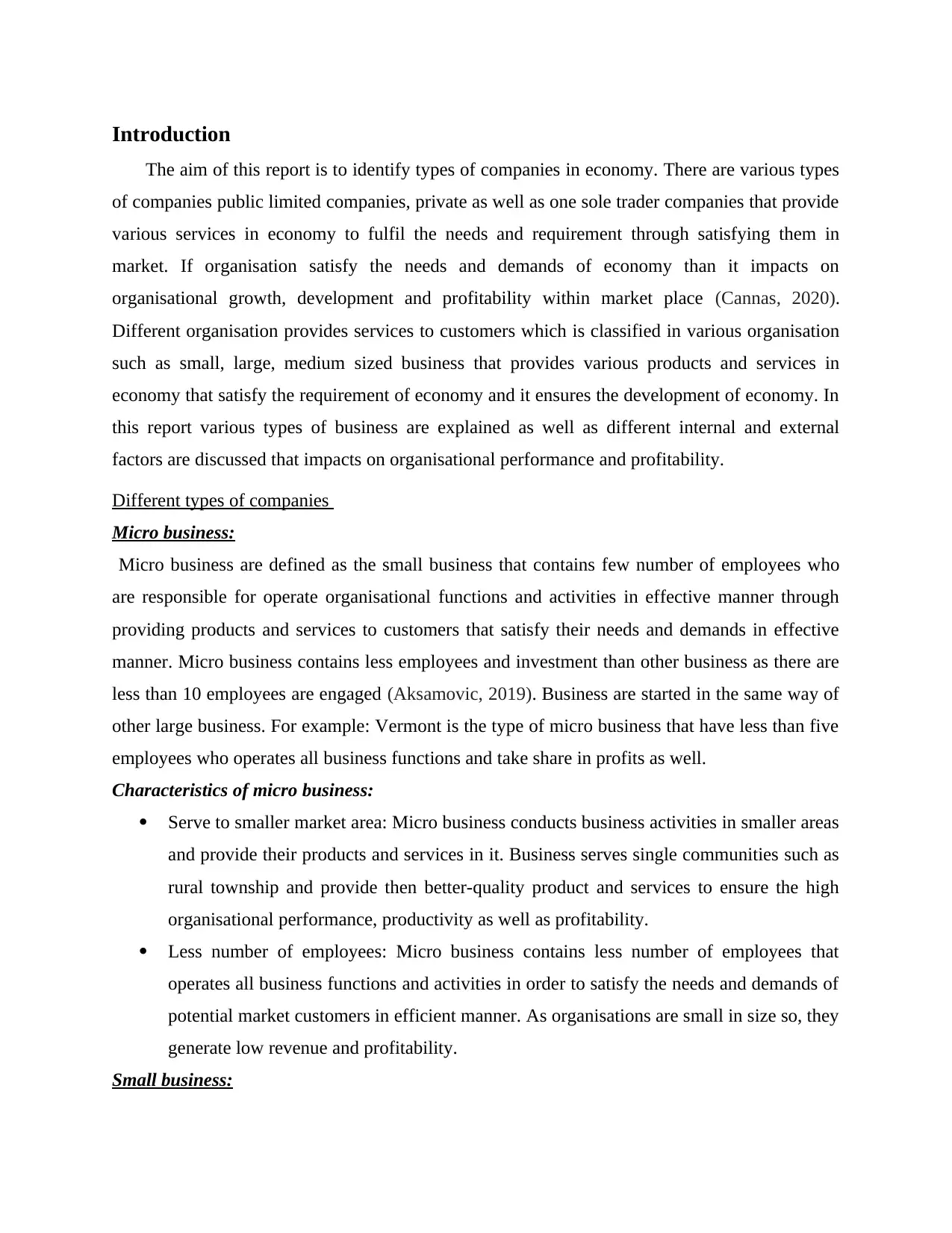
Introduction
The aim of this report is to identify types of companies in economy. There are various types
of companies public limited companies, private as well as one sole trader companies that provide
various services in economy to fulfil the needs and requirement through satisfying them in
market. If organisation satisfy the needs and demands of economy than it impacts on
organisational growth, development and profitability within market place (Cannas, 2020).
Different organisation provides services to customers which is classified in various organisation
such as small, large, medium sized business that provides various products and services in
economy that satisfy the requirement of economy and it ensures the development of economy. In
this report various types of business are explained as well as different internal and external
factors are discussed that impacts on organisational performance and profitability.
Different types of companies
Micro business:
Micro business are defined as the small business that contains few number of employees who
are responsible for operate organisational functions and activities in effective manner through
providing products and services to customers that satisfy their needs and demands in effective
manner. Micro business contains less employees and investment than other business as there are
less than 10 employees are engaged (Aksamovic, 2019). Business are started in the same way of
other large business. For example: Vermont is the type of micro business that have less than five
employees who operates all business functions and take share in profits as well.
Characteristics of micro business:
Serve to smaller market area: Micro business conducts business activities in smaller areas
and provide their products and services in it. Business serves single communities such as
rural township and provide then better-quality product and services to ensure the high
organisational performance, productivity as well as profitability.
Less number of employees: Micro business contains less number of employees that
operates all business functions and activities in order to satisfy the needs and demands of
potential market customers in efficient manner. As organisations are small in size so, they
generate low revenue and profitability.
Small business:
The aim of this report is to identify types of companies in economy. There are various types
of companies public limited companies, private as well as one sole trader companies that provide
various services in economy to fulfil the needs and requirement through satisfying them in
market. If organisation satisfy the needs and demands of economy than it impacts on
organisational growth, development and profitability within market place (Cannas, 2020).
Different organisation provides services to customers which is classified in various organisation
such as small, large, medium sized business that provides various products and services in
economy that satisfy the requirement of economy and it ensures the development of economy. In
this report various types of business are explained as well as different internal and external
factors are discussed that impacts on organisational performance and profitability.
Different types of companies
Micro business:
Micro business are defined as the small business that contains few number of employees who
are responsible for operate organisational functions and activities in effective manner through
providing products and services to customers that satisfy their needs and demands in effective
manner. Micro business contains less employees and investment than other business as there are
less than 10 employees are engaged (Aksamovic, 2019). Business are started in the same way of
other large business. For example: Vermont is the type of micro business that have less than five
employees who operates all business functions and take share in profits as well.
Characteristics of micro business:
Serve to smaller market area: Micro business conducts business activities in smaller areas
and provide their products and services in it. Business serves single communities such as
rural township and provide then better-quality product and services to ensure the high
organisational performance, productivity as well as profitability.
Less number of employees: Micro business contains less number of employees that
operates all business functions and activities in order to satisfy the needs and demands of
potential market customers in efficient manner. As organisations are small in size so, they
generate low revenue and profitability.
Small business:
⊘ This is a preview!⊘
Do you want full access?
Subscribe today to unlock all pages.

Trusted by 1+ million students worldwide
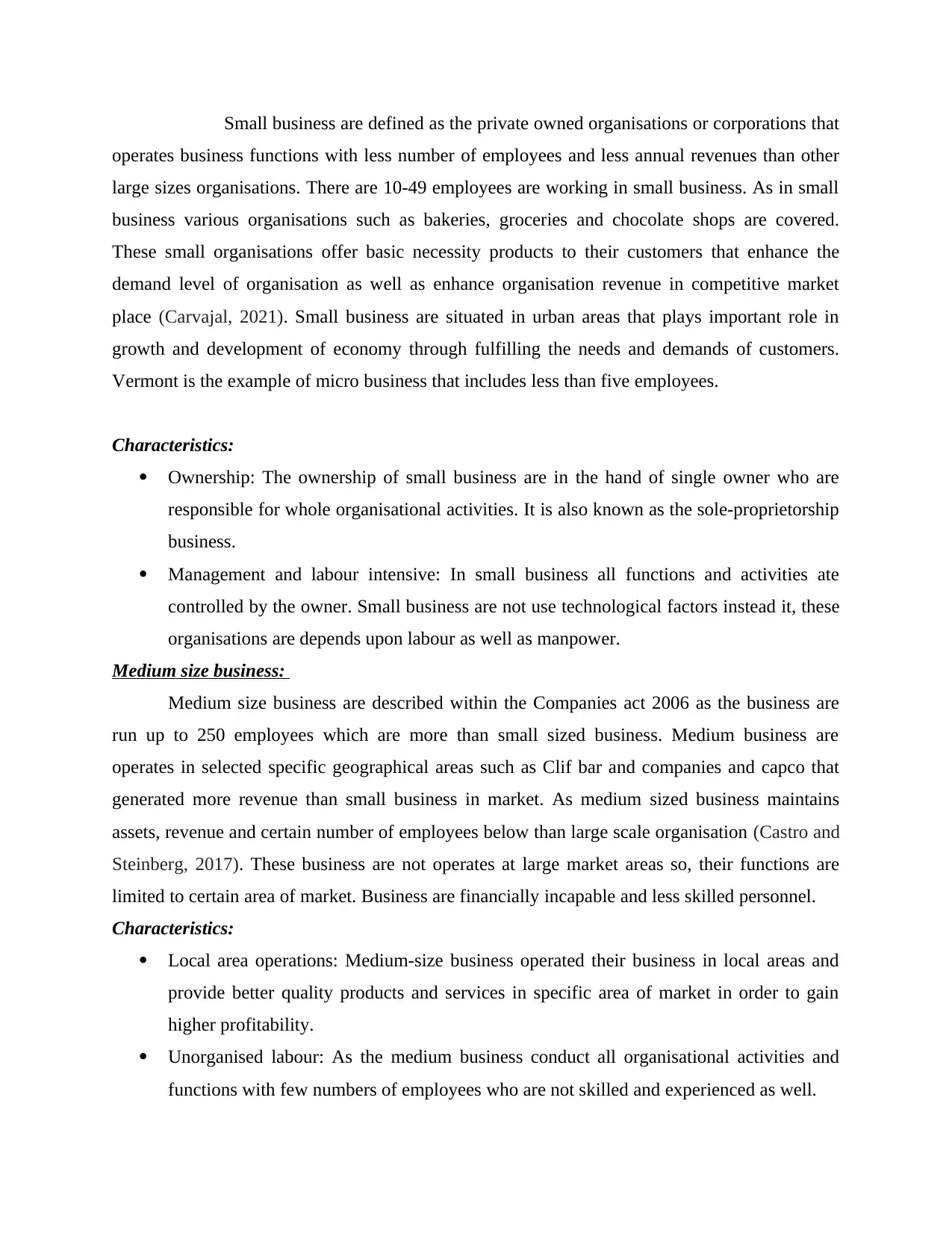
Small business are defined as the private owned organisations or corporations that
operates business functions with less number of employees and less annual revenues than other
large sizes organisations. There are 10-49 employees are working in small business. As in small
business various organisations such as bakeries, groceries and chocolate shops are covered.
These small organisations offer basic necessity products to their customers that enhance the
demand level of organisation as well as enhance organisation revenue in competitive market
place (Carvajal, 2021). Small business are situated in urban areas that plays important role in
growth and development of economy through fulfilling the needs and demands of customers.
Vermont is the example of micro business that includes less than five employees.
Characteristics:
Ownership: The ownership of small business are in the hand of single owner who are
responsible for whole organisational activities. It is also known as the sole-proprietorship
business.
Management and labour intensive: In small business all functions and activities ate
controlled by the owner. Small business are not use technological factors instead it, these
organisations are depends upon labour as well as manpower.
Medium size business:
Medium size business are described within the Companies act 2006 as the business are
run up to 250 employees which are more than small sized business. Medium business are
operates in selected specific geographical areas such as Clif bar and companies and capco that
generated more revenue than small business in market. As medium sized business maintains
assets, revenue and certain number of employees below than large scale organisation (Castro and
Steinberg, 2017). These business are not operates at large market areas so, their functions are
limited to certain area of market. Business are financially incapable and less skilled personnel.
Characteristics:
Local area operations: Medium-size business operated their business in local areas and
provide better quality products and services in specific area of market in order to gain
higher profitability.
Unorganised labour: As the medium business conduct all organisational activities and
functions with few numbers of employees who are not skilled and experienced as well.
operates business functions with less number of employees and less annual revenues than other
large sizes organisations. There are 10-49 employees are working in small business. As in small
business various organisations such as bakeries, groceries and chocolate shops are covered.
These small organisations offer basic necessity products to their customers that enhance the
demand level of organisation as well as enhance organisation revenue in competitive market
place (Carvajal, 2021). Small business are situated in urban areas that plays important role in
growth and development of economy through fulfilling the needs and demands of customers.
Vermont is the example of micro business that includes less than five employees.
Characteristics:
Ownership: The ownership of small business are in the hand of single owner who are
responsible for whole organisational activities. It is also known as the sole-proprietorship
business.
Management and labour intensive: In small business all functions and activities ate
controlled by the owner. Small business are not use technological factors instead it, these
organisations are depends upon labour as well as manpower.
Medium size business:
Medium size business are described within the Companies act 2006 as the business are
run up to 250 employees which are more than small sized business. Medium business are
operates in selected specific geographical areas such as Clif bar and companies and capco that
generated more revenue than small business in market. As medium sized business maintains
assets, revenue and certain number of employees below than large scale organisation (Castro and
Steinberg, 2017). These business are not operates at large market areas so, their functions are
limited to certain area of market. Business are financially incapable and less skilled personnel.
Characteristics:
Local area operations: Medium-size business operated their business in local areas and
provide better quality products and services in specific area of market in order to gain
higher profitability.
Unorganised labour: As the medium business conduct all organisational activities and
functions with few numbers of employees who are not skilled and experienced as well.
Paraphrase This Document
Need a fresh take? Get an instant paraphrase of this document with our AI Paraphraser
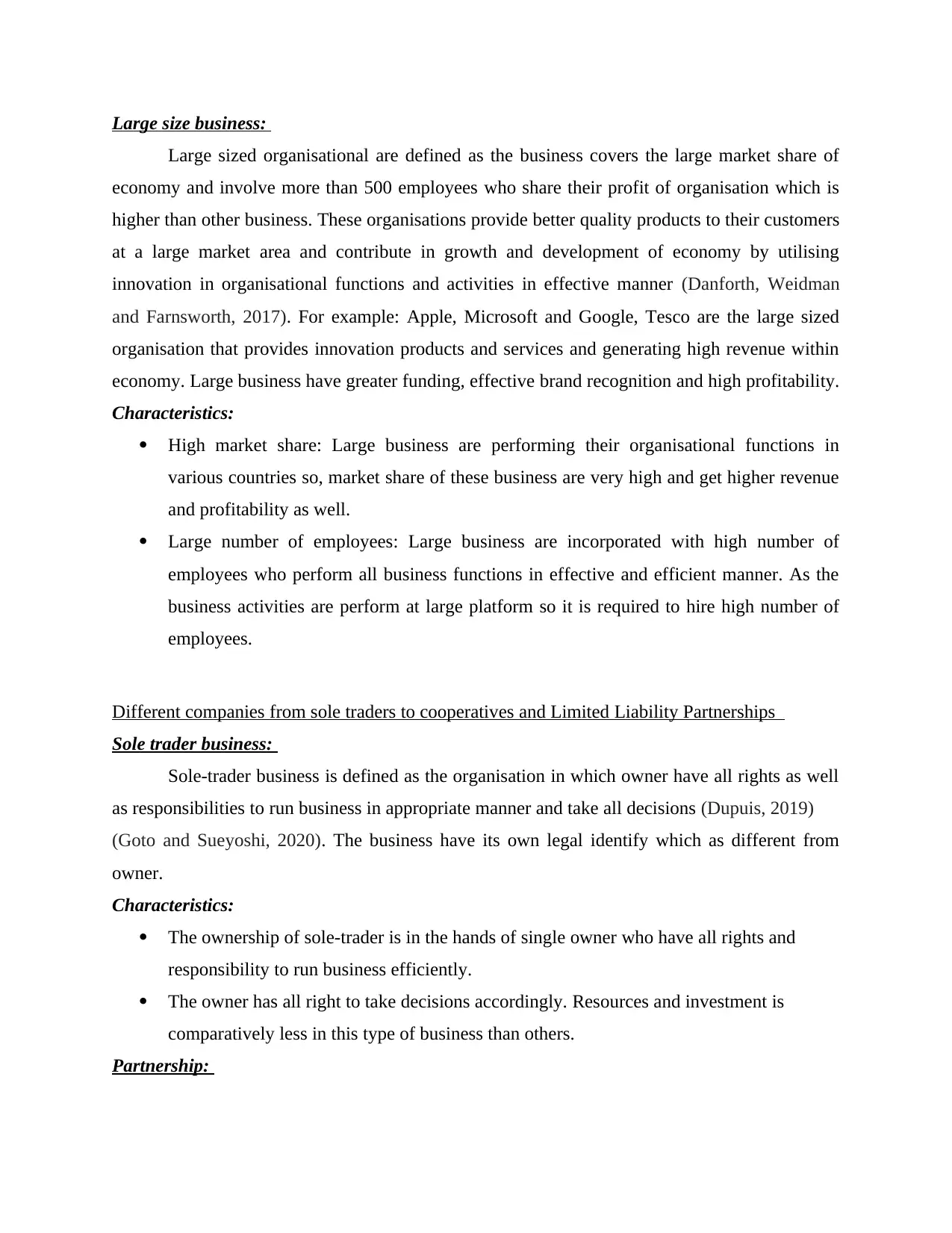
Large size business:
Large sized organisational are defined as the business covers the large market share of
economy and involve more than 500 employees who share their profit of organisation which is
higher than other business. These organisations provide better quality products to their customers
at a large market area and contribute in growth and development of economy by utilising
innovation in organisational functions and activities in effective manner (Danforth, Weidman
and Farnsworth, 2017). For example: Apple, Microsoft and Google, Tesco are the large sized
organisation that provides innovation products and services and generating high revenue within
economy. Large business have greater funding, effective brand recognition and high profitability.
Characteristics:
High market share: Large business are performing their organisational functions in
various countries so, market share of these business are very high and get higher revenue
and profitability as well.
Large number of employees: Large business are incorporated with high number of
employees who perform all business functions in effective and efficient manner. As the
business activities are perform at large platform so it is required to hire high number of
employees.
Different companies from sole traders to cooperatives and Limited Liability Partnerships
Sole trader business:
Sole-trader business is defined as the organisation in which owner have all rights as well
as responsibilities to run business in appropriate manner and take all decisions (Dupuis, 2019)
(Goto and Sueyoshi, 2020). The business have its own legal identify which as different from
owner.
Characteristics:
The ownership of sole-trader is in the hands of single owner who have all rights and
responsibility to run business efficiently.
The owner has all right to take decisions accordingly. Resources and investment is
comparatively less in this type of business than others.
Partnership:
Large sized organisational are defined as the business covers the large market share of
economy and involve more than 500 employees who share their profit of organisation which is
higher than other business. These organisations provide better quality products to their customers
at a large market area and contribute in growth and development of economy by utilising
innovation in organisational functions and activities in effective manner (Danforth, Weidman
and Farnsworth, 2017). For example: Apple, Microsoft and Google, Tesco are the large sized
organisation that provides innovation products and services and generating high revenue within
economy. Large business have greater funding, effective brand recognition and high profitability.
Characteristics:
High market share: Large business are performing their organisational functions in
various countries so, market share of these business are very high and get higher revenue
and profitability as well.
Large number of employees: Large business are incorporated with high number of
employees who perform all business functions in effective and efficient manner. As the
business activities are perform at large platform so it is required to hire high number of
employees.
Different companies from sole traders to cooperatives and Limited Liability Partnerships
Sole trader business:
Sole-trader business is defined as the organisation in which owner have all rights as well
as responsibilities to run business in appropriate manner and take all decisions (Dupuis, 2019)
(Goto and Sueyoshi, 2020). The business have its own legal identify which as different from
owner.
Characteristics:
The ownership of sole-trader is in the hands of single owner who have all rights and
responsibility to run business efficiently.
The owner has all right to take decisions accordingly. Resources and investment is
comparatively less in this type of business than others.
Partnership:
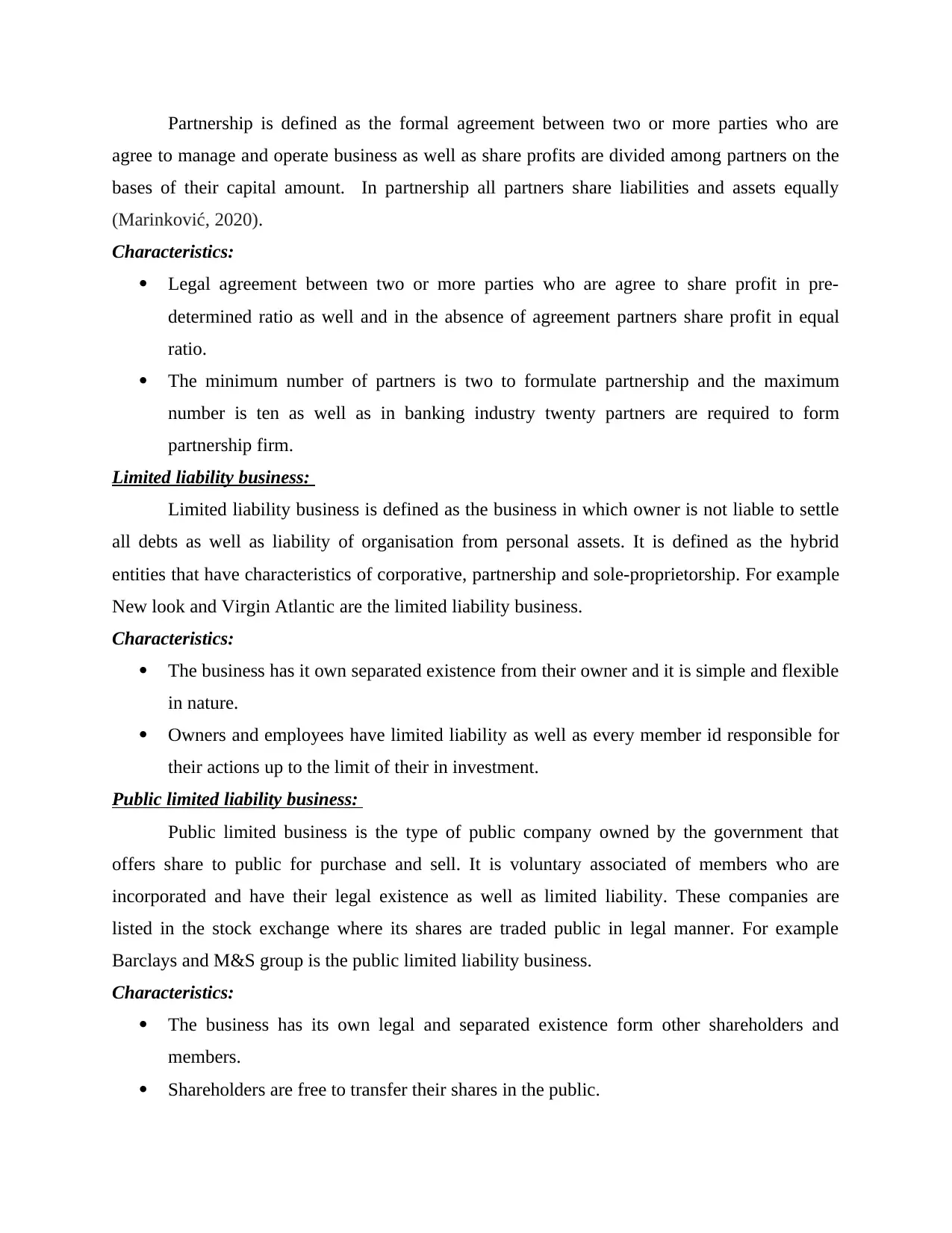
Partnership is defined as the formal agreement between two or more parties who are
agree to manage and operate business as well as share profits are divided among partners on the
bases of their capital amount. In partnership all partners share liabilities and assets equally
(Marinković, 2020).
Characteristics:
Legal agreement between two or more parties who are agree to share profit in pre-
determined ratio as well and in the absence of agreement partners share profit in equal
ratio.
The minimum number of partners is two to formulate partnership and the maximum
number is ten as well as in banking industry twenty partners are required to form
partnership firm.
Limited liability business:
Limited liability business is defined as the business in which owner is not liable to settle
all debts as well as liability of organisation from personal assets. It is defined as the hybrid
entities that have characteristics of corporative, partnership and sole-proprietorship. For example
New look and Virgin Atlantic are the limited liability business.
Characteristics:
The business has it own separated existence from their owner and it is simple and flexible
in nature.
Owners and employees have limited liability as well as every member id responsible for
their actions up to the limit of their in investment.
Public limited liability business:
Public limited business is the type of public company owned by the government that
offers share to public for purchase and sell. It is voluntary associated of members who are
incorporated and have their legal existence as well as limited liability. These companies are
listed in the stock exchange where its shares are traded public in legal manner. For example
Barclays and M&S group is the public limited liability business.
Characteristics:
The business has its own legal and separated existence form other shareholders and
members.
Shareholders are free to transfer their shares in the public.
agree to manage and operate business as well as share profits are divided among partners on the
bases of their capital amount. In partnership all partners share liabilities and assets equally
(Marinković, 2020).
Characteristics:
Legal agreement between two or more parties who are agree to share profit in pre-
determined ratio as well and in the absence of agreement partners share profit in equal
ratio.
The minimum number of partners is two to formulate partnership and the maximum
number is ten as well as in banking industry twenty partners are required to form
partnership firm.
Limited liability business:
Limited liability business is defined as the business in which owner is not liable to settle
all debts as well as liability of organisation from personal assets. It is defined as the hybrid
entities that have characteristics of corporative, partnership and sole-proprietorship. For example
New look and Virgin Atlantic are the limited liability business.
Characteristics:
The business has it own separated existence from their owner and it is simple and flexible
in nature.
Owners and employees have limited liability as well as every member id responsible for
their actions up to the limit of their in investment.
Public limited liability business:
Public limited business is the type of public company owned by the government that
offers share to public for purchase and sell. It is voluntary associated of members who are
incorporated and have their legal existence as well as limited liability. These companies are
listed in the stock exchange where its shares are traded public in legal manner. For example
Barclays and M&S group is the public limited liability business.
Characteristics:
The business has its own legal and separated existence form other shareholders and
members.
Shareholders are free to transfer their shares in the public.
⊘ This is a preview!⊘
Do you want full access?
Subscribe today to unlock all pages.

Trusted by 1+ million students worldwide
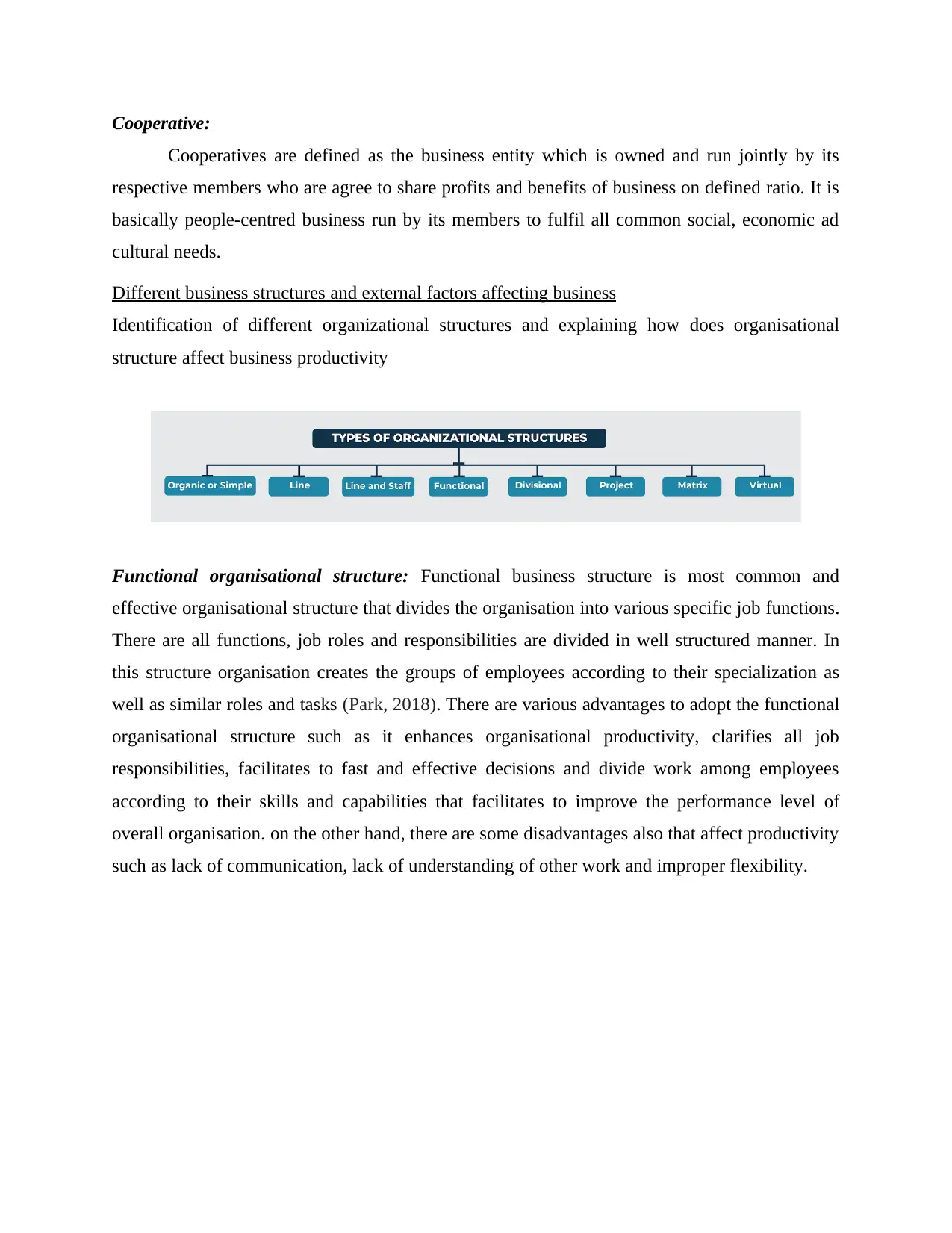
Cooperative:
Cooperatives are defined as the business entity which is owned and run jointly by its
respective members who are agree to share profits and benefits of business on defined ratio. It is
basically people-centred business run by its members to fulfil all common social, economic ad
cultural needs.
Different business structures and external factors affecting business
Identification of different organizational structures and explaining how does organisational
structure affect business productivity
Functional organisational structure: Functional business structure is most common and
effective organisational structure that divides the organisation into various specific job functions.
There are all functions, job roles and responsibilities are divided in well structured manner. In
this structure organisation creates the groups of employees according to their specialization as
well as similar roles and tasks (Park, 2018). There are various advantages to adopt the functional
organisational structure such as it enhances organisational productivity, clarifies all job
responsibilities, facilitates to fast and effective decisions and divide work among employees
according to their skills and capabilities that facilitates to improve the performance level of
overall organisation. on the other hand, there are some disadvantages also that affect productivity
such as lack of communication, lack of understanding of other work and improper flexibility.
Cooperatives are defined as the business entity which is owned and run jointly by its
respective members who are agree to share profits and benefits of business on defined ratio. It is
basically people-centred business run by its members to fulfil all common social, economic ad
cultural needs.
Different business structures and external factors affecting business
Identification of different organizational structures and explaining how does organisational
structure affect business productivity
Functional organisational structure: Functional business structure is most common and
effective organisational structure that divides the organisation into various specific job functions.
There are all functions, job roles and responsibilities are divided in well structured manner. In
this structure organisation creates the groups of employees according to their specialization as
well as similar roles and tasks (Park, 2018). There are various advantages to adopt the functional
organisational structure such as it enhances organisational productivity, clarifies all job
responsibilities, facilitates to fast and effective decisions and divide work among employees
according to their skills and capabilities that facilitates to improve the performance level of
overall organisation. on the other hand, there are some disadvantages also that affect productivity
such as lack of communication, lack of understanding of other work and improper flexibility.
Paraphrase This Document
Need a fresh take? Get an instant paraphrase of this document with our AI Paraphraser
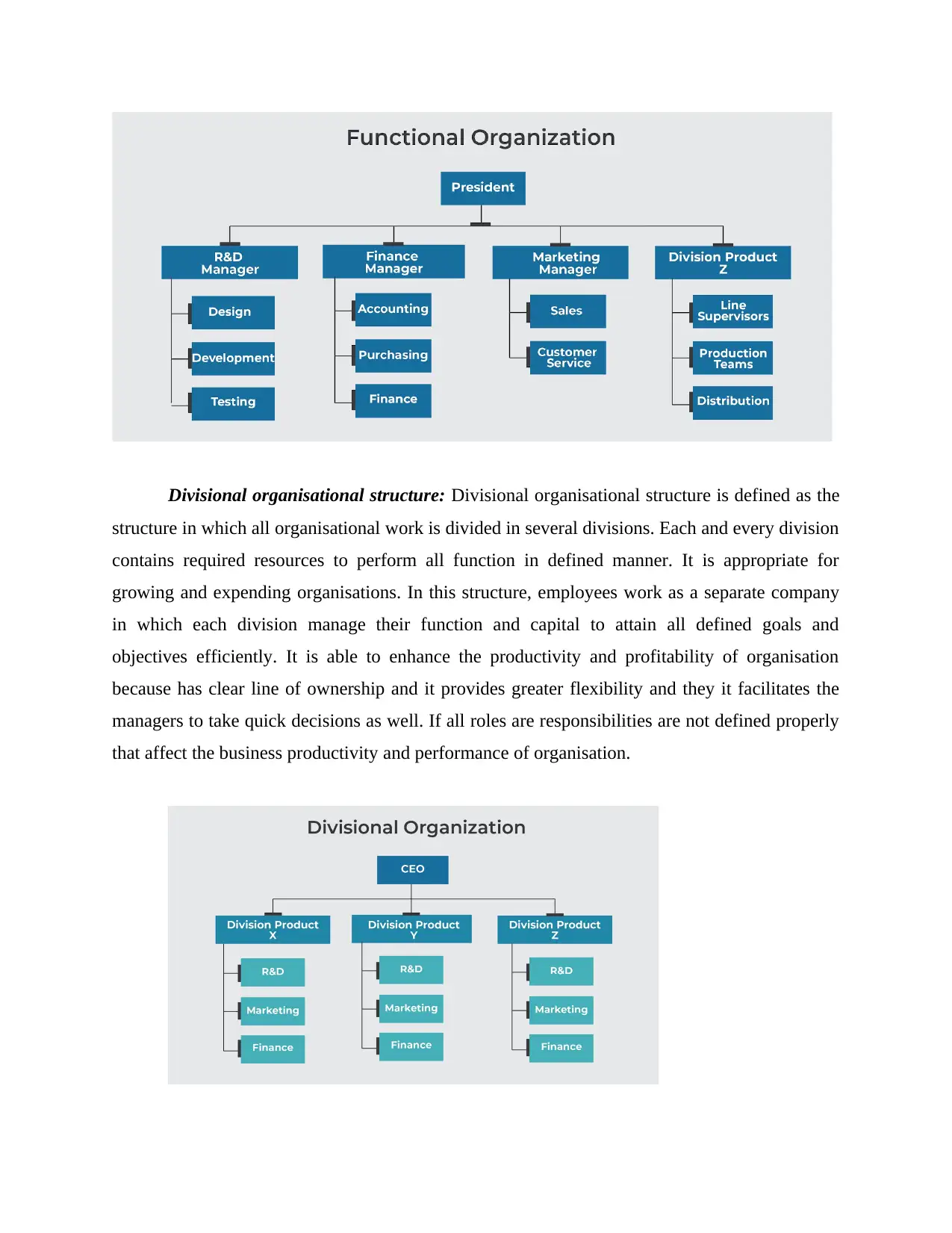
Divisional organisational structure: Divisional organisational structure is defined as the
structure in which all organisational work is divided in several divisions. Each and every division
contains required resources to perform all function in defined manner. It is appropriate for
growing and expending organisations. In this structure, employees work as a separate company
in which each division manage their function and capital to attain all defined goals and
objectives efficiently. It is able to enhance the productivity and profitability of organisation
because has clear line of ownership and it provides greater flexibility and they it facilitates the
managers to take quick decisions as well. If all roles are responsibilities are not defined properly
that affect the business productivity and performance of organisation.
structure in which all organisational work is divided in several divisions. Each and every division
contains required resources to perform all function in defined manner. It is appropriate for
growing and expending organisations. In this structure, employees work as a separate company
in which each division manage their function and capital to attain all defined goals and
objectives efficiently. It is able to enhance the productivity and profitability of organisation
because has clear line of ownership and it provides greater flexibility and they it facilitates the
managers to take quick decisions as well. If all roles are responsibilities are not defined properly
that affect the business productivity and performance of organisation.
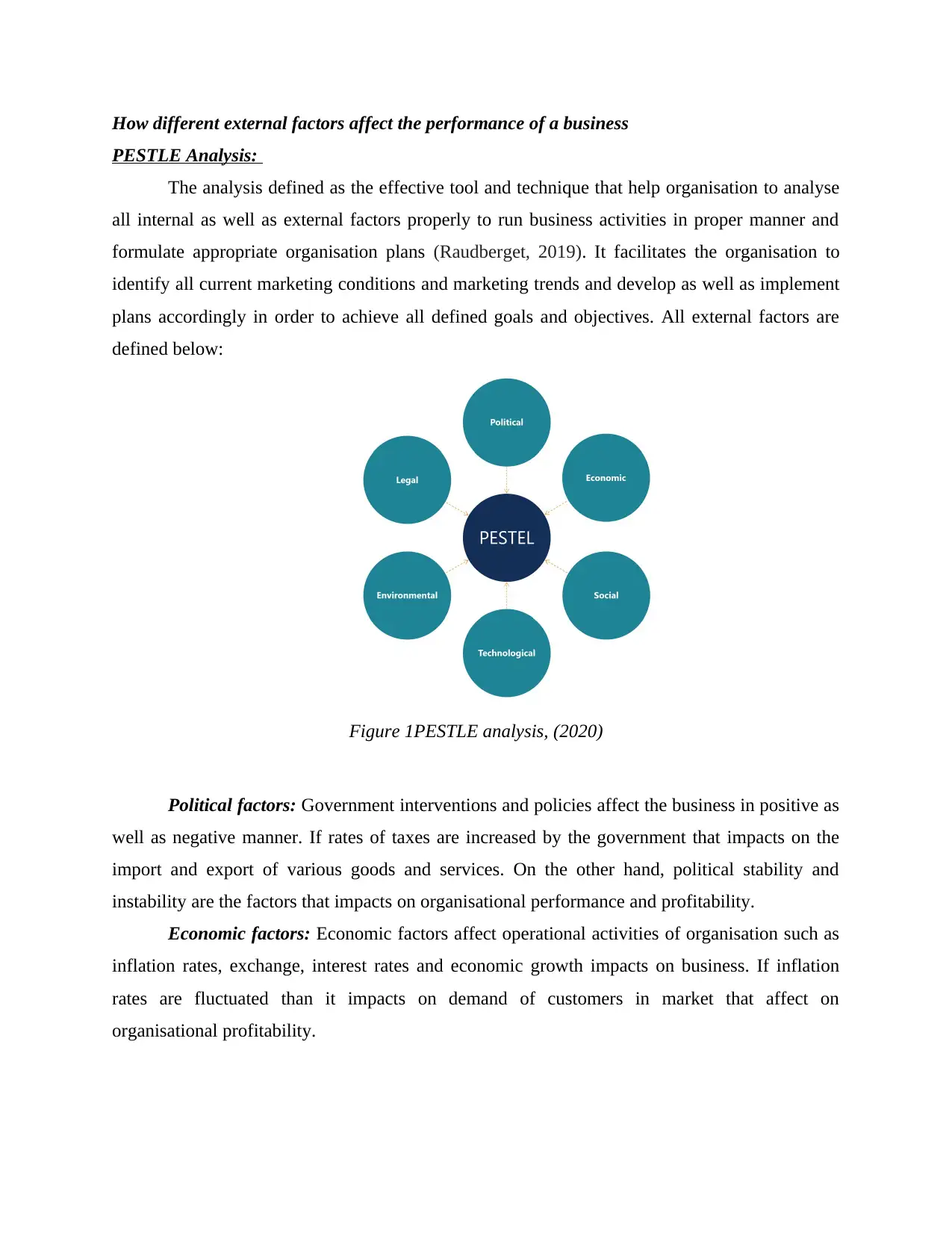
How different external factors affect the performance of a business
PESTLE Analysis:
The analysis defined as the effective tool and technique that help organisation to analyse
all internal as well as external factors properly to run business activities in proper manner and
formulate appropriate organisation plans (Raudberget, 2019). It facilitates the organisation to
identify all current marketing conditions and marketing trends and develop as well as implement
plans accordingly in order to achieve all defined goals and objectives. All external factors are
defined below:
Figure 1PESTLE analysis, (2020)
Political factors: Government interventions and policies affect the business in positive as
well as negative manner. If rates of taxes are increased by the government that impacts on the
import and export of various goods and services. On the other hand, political stability and
instability are the factors that impacts on organisational performance and profitability.
Economic factors: Economic factors affect operational activities of organisation such as
inflation rates, exchange, interest rates and economic growth impacts on business. If inflation
rates are fluctuated than it impacts on demand of customers in market that affect on
organisational profitability.
PESTLE Analysis:
The analysis defined as the effective tool and technique that help organisation to analyse
all internal as well as external factors properly to run business activities in proper manner and
formulate appropriate organisation plans (Raudberget, 2019). It facilitates the organisation to
identify all current marketing conditions and marketing trends and develop as well as implement
plans accordingly in order to achieve all defined goals and objectives. All external factors are
defined below:
Figure 1PESTLE analysis, (2020)
Political factors: Government interventions and policies affect the business in positive as
well as negative manner. If rates of taxes are increased by the government that impacts on the
import and export of various goods and services. On the other hand, political stability and
instability are the factors that impacts on organisational performance and profitability.
Economic factors: Economic factors affect operational activities of organisation such as
inflation rates, exchange, interest rates and economic growth impacts on business. If inflation
rates are fluctuated than it impacts on demand of customers in market that affect on
organisational profitability.
⊘ This is a preview!⊘
Do you want full access?
Subscribe today to unlock all pages.

Trusted by 1+ million students worldwide
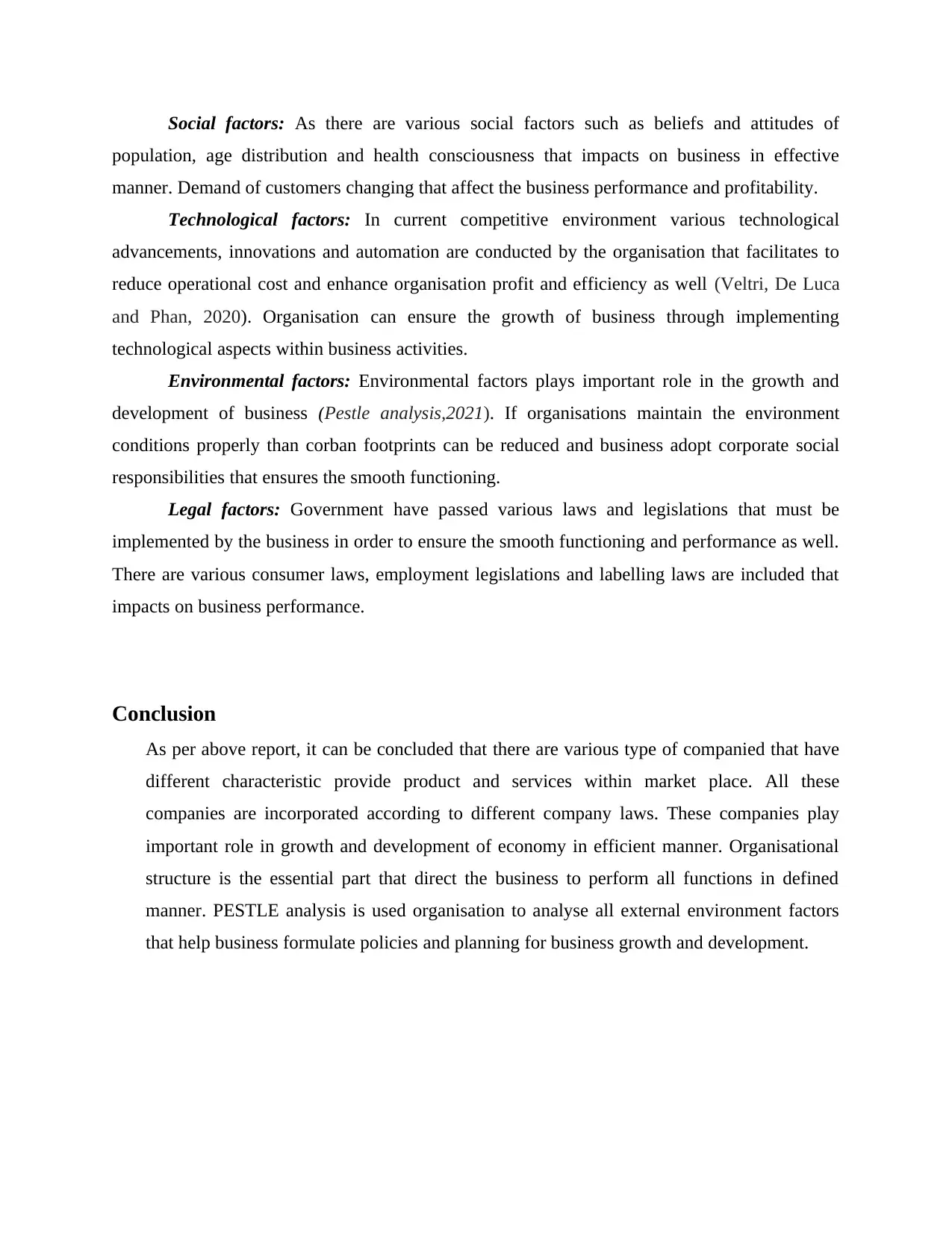
Social factors: As there are various social factors such as beliefs and attitudes of
population, age distribution and health consciousness that impacts on business in effective
manner. Demand of customers changing that affect the business performance and profitability.
Technological factors: In current competitive environment various technological
advancements, innovations and automation are conducted by the organisation that facilitates to
reduce operational cost and enhance organisation profit and efficiency as well (Veltri, De Luca
and Phan, 2020). Organisation can ensure the growth of business through implementing
technological aspects within business activities.
Environmental factors: Environmental factors plays important role in the growth and
development of business (Pestle analysis,2021). If organisations maintain the environment
conditions properly than corban footprints can be reduced and business adopt corporate social
responsibilities that ensures the smooth functioning.
Legal factors: Government have passed various laws and legislations that must be
implemented by the business in order to ensure the smooth functioning and performance as well.
There are various consumer laws, employment legislations and labelling laws are included that
impacts on business performance.
Conclusion
As per above report, it can be concluded that there are various type of companied that have
different characteristic provide product and services within market place. All these
companies are incorporated according to different company laws. These companies play
important role in growth and development of economy in efficient manner. Organisational
structure is the essential part that direct the business to perform all functions in defined
manner. PESTLE analysis is used organisation to analyse all external environment factors
that help business formulate policies and planning for business growth and development.
population, age distribution and health consciousness that impacts on business in effective
manner. Demand of customers changing that affect the business performance and profitability.
Technological factors: In current competitive environment various technological
advancements, innovations and automation are conducted by the organisation that facilitates to
reduce operational cost and enhance organisation profit and efficiency as well (Veltri, De Luca
and Phan, 2020). Organisation can ensure the growth of business through implementing
technological aspects within business activities.
Environmental factors: Environmental factors plays important role in the growth and
development of business (Pestle analysis,2021). If organisations maintain the environment
conditions properly than corban footprints can be reduced and business adopt corporate social
responsibilities that ensures the smooth functioning.
Legal factors: Government have passed various laws and legislations that must be
implemented by the business in order to ensure the smooth functioning and performance as well.
There are various consumer laws, employment legislations and labelling laws are included that
impacts on business performance.
Conclusion
As per above report, it can be concluded that there are various type of companied that have
different characteristic provide product and services within market place. All these
companies are incorporated according to different company laws. These companies play
important role in growth and development of economy in efficient manner. Organisational
structure is the essential part that direct the business to perform all functions in defined
manner. PESTLE analysis is used organisation to analyse all external environment factors
that help business formulate policies and planning for business growth and development.
Paraphrase This Document
Need a fresh take? Get an instant paraphrase of this document with our AI Paraphraser

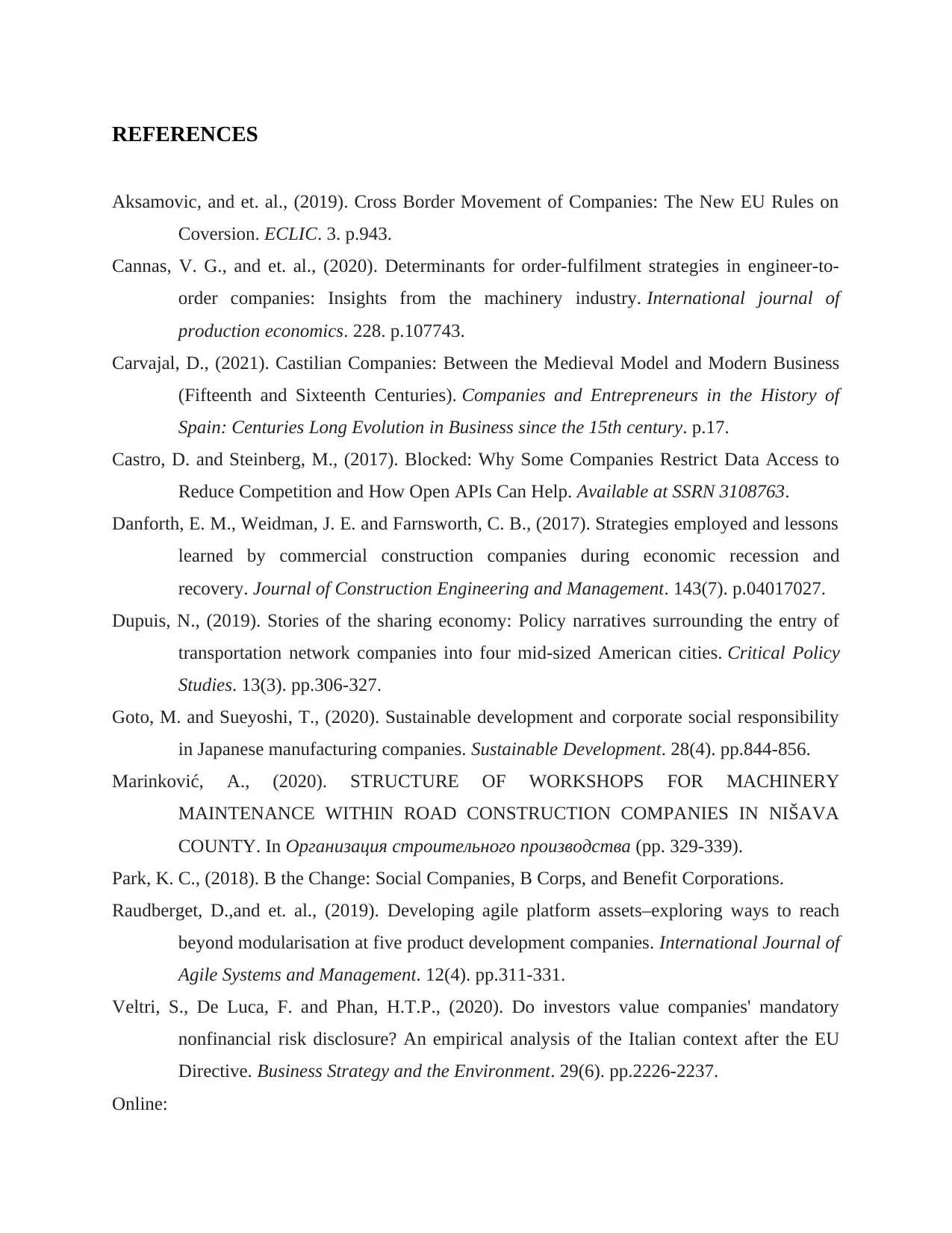
REFERENCES
Aksamovic, and et. al., (2019). Cross Border Movement of Companies: The New EU Rules on
Coversion. ECLIC. 3. p.943.
Cannas, V. G., and et. al., (2020). Determinants for order-fulfilment strategies in engineer-to-
order companies: Insights from the machinery industry. International journal of
production economics. 228. p.107743.
Carvajal, D., (2021). Castilian Companies: Between the Medieval Model and Modern Business
(Fifteenth and Sixteenth Centuries). Companies and Entrepreneurs in the History of
Spain: Centuries Long Evolution in Business since the 15th century. p.17.
Castro, D. and Steinberg, M., (2017). Blocked: Why Some Companies Restrict Data Access to
Reduce Competition and How Open APIs Can Help. Available at SSRN 3108763.
Danforth, E. M., Weidman, J. E. and Farnsworth, C. B., (2017). Strategies employed and lessons
learned by commercial construction companies during economic recession and
recovery. Journal of Construction Engineering and Management. 143(7). p.04017027.
Dupuis, N., (2019). Stories of the sharing economy: Policy narratives surrounding the entry of
transportation network companies into four mid-sized American cities. Critical Policy
Studies. 13(3). pp.306-327.
Goto, M. and Sueyoshi, T., (2020). Sustainable development and corporate social responsibility
in Japanese manufacturing companies. Sustainable Development. 28(4). pp.844-856.
Marinković, A., (2020). STRUCTURE OF WORKSHOPS FOR MACHINERY
MAINTENANCE WITHIN ROAD CONSTRUCTION COMPANIES IN NIŠAVA
COUNTY. In Организация строительного производства (pp. 329-339).
Park, K. C., (2018). B the Change: Social Companies, B Corps, and Benefit Corporations.
Raudberget, D.,and et. al., (2019). Developing agile platform assets–exploring ways to reach
beyond modularisation at five product development companies. International Journal of
Agile Systems and Management. 12(4). pp.311-331.
Veltri, S., De Luca, F. and Phan, H.T.P., (2020). Do investors value companies' mandatory
nonfinancial risk disclosure? An empirical analysis of the Italian context after the EU
Directive. Business Strategy and the Environment. 29(6). pp.2226-2237.
Online:
Aksamovic, and et. al., (2019). Cross Border Movement of Companies: The New EU Rules on
Coversion. ECLIC. 3. p.943.
Cannas, V. G., and et. al., (2020). Determinants for order-fulfilment strategies in engineer-to-
order companies: Insights from the machinery industry. International journal of
production economics. 228. p.107743.
Carvajal, D., (2021). Castilian Companies: Between the Medieval Model and Modern Business
(Fifteenth and Sixteenth Centuries). Companies and Entrepreneurs in the History of
Spain: Centuries Long Evolution in Business since the 15th century. p.17.
Castro, D. and Steinberg, M., (2017). Blocked: Why Some Companies Restrict Data Access to
Reduce Competition and How Open APIs Can Help. Available at SSRN 3108763.
Danforth, E. M., Weidman, J. E. and Farnsworth, C. B., (2017). Strategies employed and lessons
learned by commercial construction companies during economic recession and
recovery. Journal of Construction Engineering and Management. 143(7). p.04017027.
Dupuis, N., (2019). Stories of the sharing economy: Policy narratives surrounding the entry of
transportation network companies into four mid-sized American cities. Critical Policy
Studies. 13(3). pp.306-327.
Goto, M. and Sueyoshi, T., (2020). Sustainable development and corporate social responsibility
in Japanese manufacturing companies. Sustainable Development. 28(4). pp.844-856.
Marinković, A., (2020). STRUCTURE OF WORKSHOPS FOR MACHINERY
MAINTENANCE WITHIN ROAD CONSTRUCTION COMPANIES IN NIŠAVA
COUNTY. In Организация строительного производства (pp. 329-339).
Park, K. C., (2018). B the Change: Social Companies, B Corps, and Benefit Corporations.
Raudberget, D.,and et. al., (2019). Developing agile platform assets–exploring ways to reach
beyond modularisation at five product development companies. International Journal of
Agile Systems and Management. 12(4). pp.311-331.
Veltri, S., De Luca, F. and Phan, H.T.P., (2020). Do investors value companies' mandatory
nonfinancial risk disclosure? An empirical analysis of the Italian context after the EU
Directive. Business Strategy and the Environment. 29(6). pp.2226-2237.
Online:
⊘ This is a preview!⊘
Do you want full access?
Subscribe today to unlock all pages.

Trusted by 1+ million students worldwide
1 out of 13
Related Documents
Your All-in-One AI-Powered Toolkit for Academic Success.
+13062052269
info@desklib.com
Available 24*7 on WhatsApp / Email
![[object Object]](/_next/static/media/star-bottom.7253800d.svg)
Unlock your academic potential
Copyright © 2020–2025 A2Z Services. All Rights Reserved. Developed and managed by ZUCOL.





